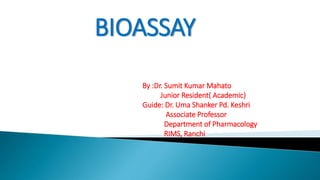1) A bioassay is a technique used to quantitatively measure the amount or functional activity of a target entity (analyte) using a biological system. It can be used to measure drugs, biochemicals, or organic samples.
2) There are three main types of assays - chemical assays, immunoassays, and bioassays. Bioassays use living biological tissues or organisms to measure pharmacological activity.
3) Bioassays are useful when the chemical structure of an active substance is unknown, it cannot be purified chemically, or its pharmacological effects need to be measured. They provide a sensitive way to standardize biologically derived drugs.


















































